Sunday, May 22, 2011
Another rainy day, more like a drizzling day.
We are off to see the second floor of the Shanghai Museum, which showcases ceramics.
Ancient peoples around the world had pottery, but porcelain belongs to the Chinese. So much so, that we call it "china."
The museum follows the development of Chinese ceramics in chronological order, and if you are really interested in the history, go to the website of Chinese collectors (http://www.ceramic-collector.org/eng/history101.html). They seem to have the labels from the Shanghai Museum, word for word, right down to the misspellings! And their photos are sharper.
Peiligang Culture (6000-5200 BCE)
Pot with bird design:
Pottery wheel first used (5000-3000 BCE)
White pottery gui/tripot pitcher:
Shandong Longshan Culture (2500–2000 BCE)
Proto-celadon jar with ears and vertical stripes:
Beginning of glazing, Warring States Period (475-211 BCE)
Pottery bell:
Warring States Period (403–221 BCE)
Soldier with a missing weapon from his right hand:
Beginning of use of color, Eastern Han Dynasty (25-220 CE)
Green-glazed pottery figure of a duck:
Eastern-Han Dynasty (25-220 CE)
Celadon huzi/chamber pot:
Celadon denotes serious transparent glazing and usually a greenish color ware, Western Jin Dynasty (265-317 CE)
Celadon jar with chicken head:
Eastern Jin Dynasty (317-420 CE)
Celadon hunping/funerary jar with sculpted designs of architecture:
Jin Dynasty (265-420 CE)
A Westerner (missing a flute) on a bactrian camel:
Sancai- (three-color) glazed figure, Tang Dynasty (618-907 CE)
Sancai-glazed tomb guardian:
Tang Dynasty (8th century)
Sancai-glazed equestrian:
Tang Dynasty (618-907 CE)
White-glazed covered jar with incised lotus petal design and "Guan" mark:
Beginning of marks, Ding ware, Five Dynasties (907-960 CE)
Polychrome-glazed dishmouth pot with rings and carved ribbon:
Liao Dynasty (916-1125)
Polychrome-glazed phoenix-head ewer with applique decoration:
Liao Dynasty (916-1125)
Moon-white glazed jar with lotus-leaf-shaped lid:
Jun ware, Northern Song Dynasty (960-1127)
Polychrome-glazed pillow with incised bird and flower design:
Yes, a pillow! Cizhou ware, Jin-Yuan Dynasty (1115-1368)
Celadon jar encircled by a dragon with lid:
Longquan ware, Southern Song Dynasty (1127-1279)
Five-footed washer (crackle):
Ge ware, Southern Song Dynasty (1127-1279)
Black-glazed vase with brown design:
Yuan Dynasty (1271-1368)
Sgraffito:
I'm not sure why this was marked sgraffito, when it is the same as incised patterns.
Foliated dish with underglaze blue design of melons, bamboo and grapes:
Jingdezhen ware, Yuan Dynasty (1271-1368)
Blue and white flask:
Ming Dynasty (1368-1644)
Blue and white bird feeder:
Ming Dynasty (1368-1644)
Bowl with red lions:
Turquoise color:
Kent with a giant Ming pot:
Blue and white oblate pot with underglaze blue design of camellia sprays:
Jingdezhen ware, Ming Dynasty Yongle Reign (1403-1424)
Double cruet on the right:
Decorations of Chinese scenes for the foreign market:
Famille Vert vase with design of Liu Bei's Marriage Story, Jingdezhen ware, Kangxi Reign Qing Dynasty (1662-1722)
Underglaze blue and red vase of flower and fruit sprays:
Jingdezhen ware, Qing Dynasty Yongzheng Reign (1723-1735)
Vase with Fencai design of oversize peaches and bats:
Jingdezhen ware, Qing Dynasty Yongzheng Reign (1723-1735)
Small orange bats?
Dish with Wucai design of birds:
Jingdezhen ware, Qing Dynasty Kangxi Reign (1662-1722)
Twin-bodied vase with enameled design of dragon and phoenix:
Jingdezhen ware, Qing Dynasty Qianlong Reign (1736-1795)
Tibetan vase with Fencai design of 8 auspicious symbols on green background:
Jingdezhen ware, Qing Dynasty Qianlong Reign (1736-1795)
From other manufacturers:
Yellow teapot:
Buddha:
Zhangzhou ware, Chenghua Reign Ming Dynasty (1465-1487). The symbol on his chest is ancient. Chinese versions include a right-handed (yang) and a left-handed (yin) version - opposites that "harmonize." It has represented the sun, the four directions, movement and change (the four appendages) and union of opposites (lines crossing).
Ahua-glazed bowl with lotus design:
Ming Dynasty (1368-1644)
Teapot with a looped handle and "Man Sheng" mark:
Yixing ware, Qing Dynasty (about 1900)
Pair of bowls with lids:
From Zande Lou Collection, a private collection.
Walked through People's Square and Park to have lunch.
Pigeons in the trees:
Pigeons in the grass:
Pigeons on the sidewalk:
Magnolia blossom:
Tea exposition, from the ethnic groups:
Miao traditional dress above, unidentified below:
Unusual architecture on Huanghe Road:
We had lunch at the unassuming Jia Jia Restaurant:
Girls making the pork and crab dumplings:
A fancier restaurant:
The Shanghai Metro mascot, "Chang Chang":





















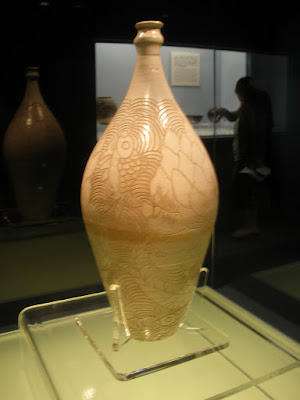
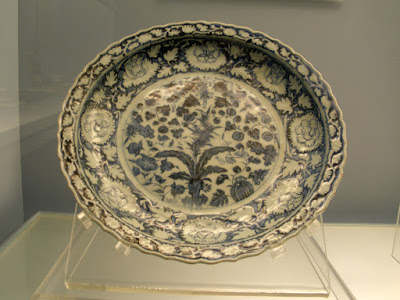





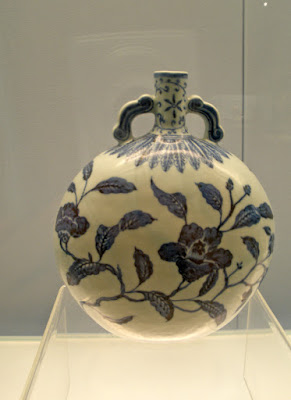








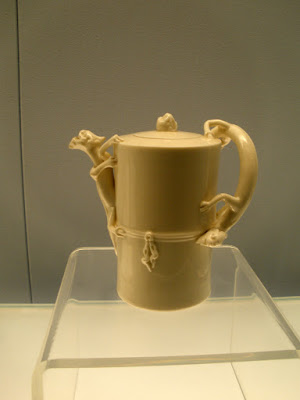



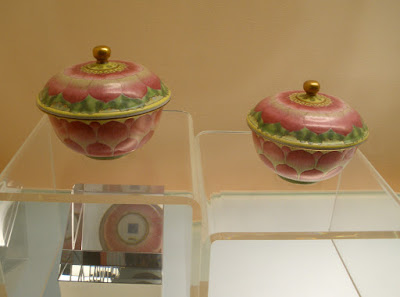












No comments:
Post a Comment